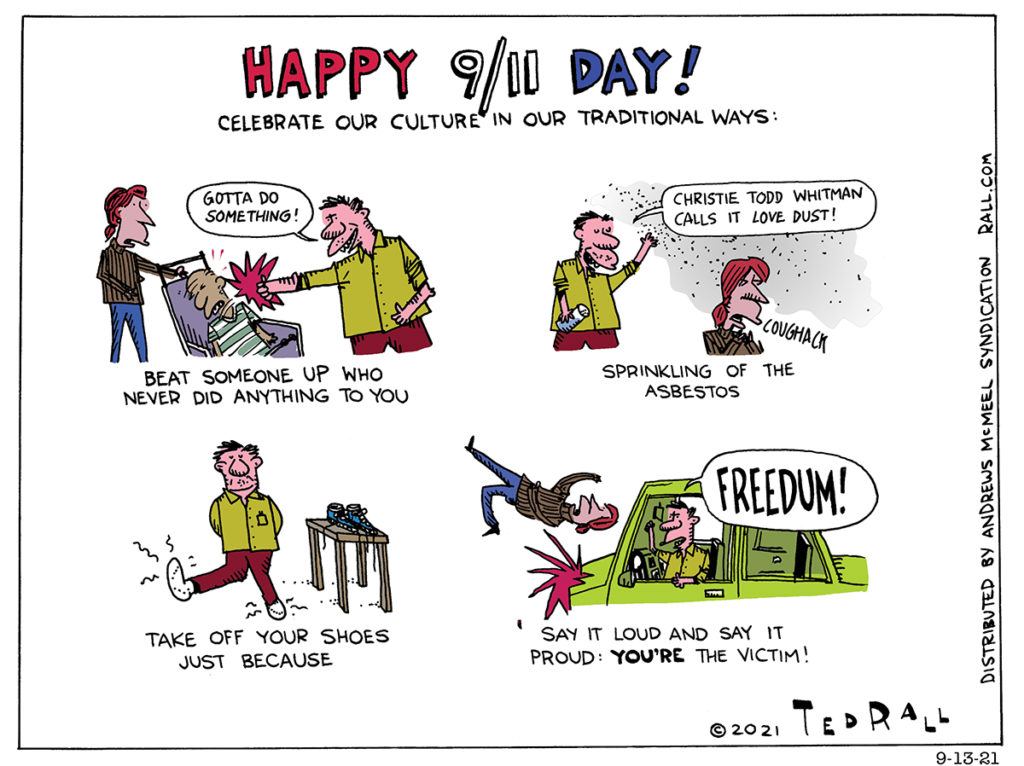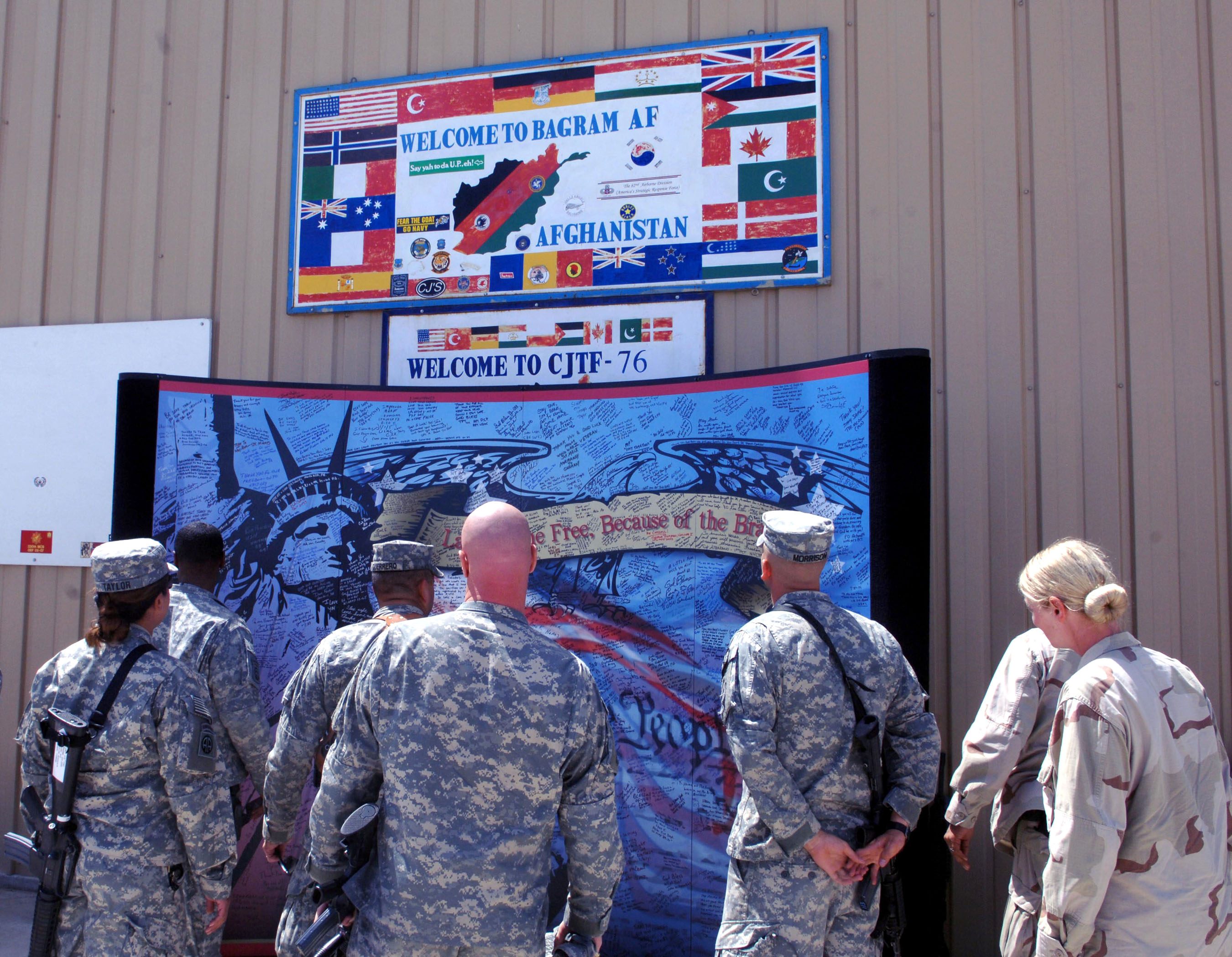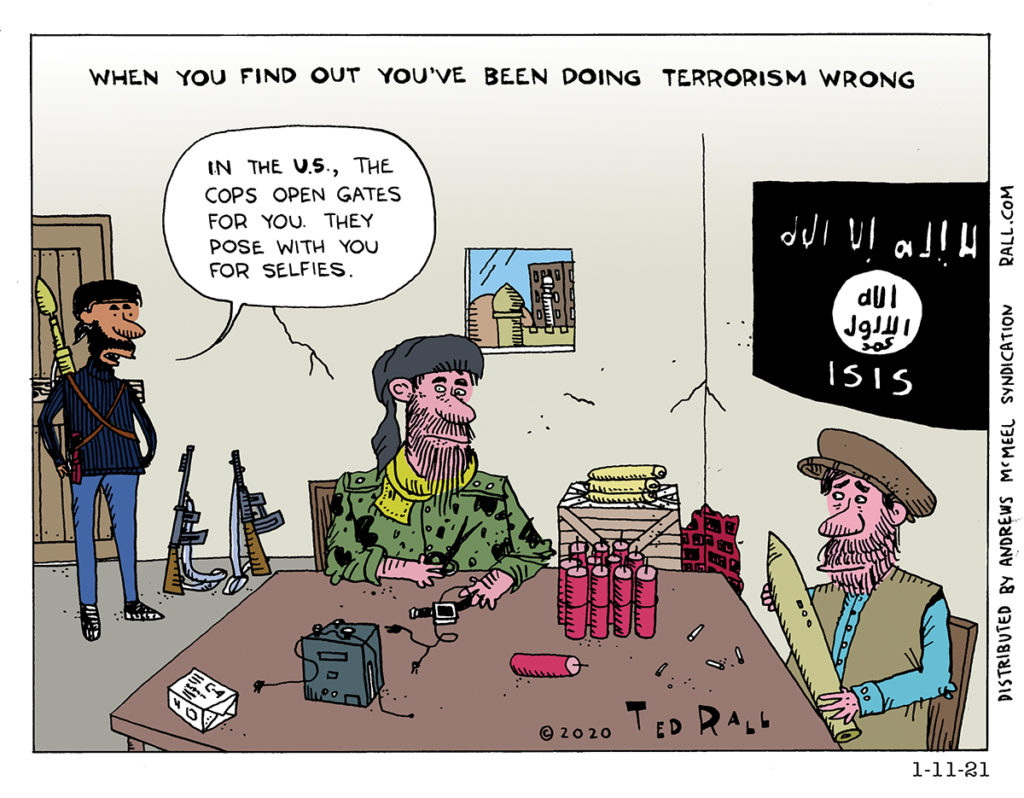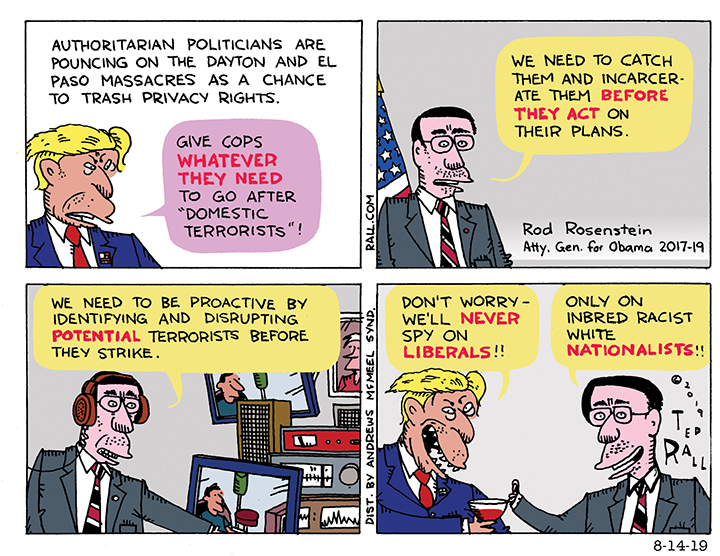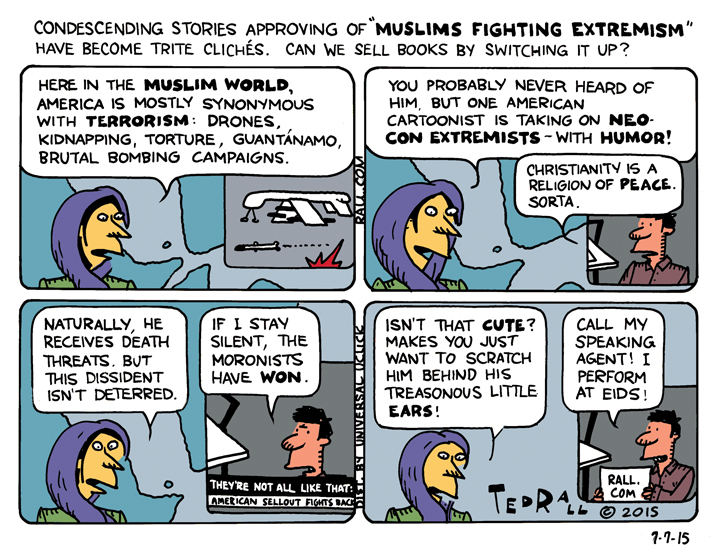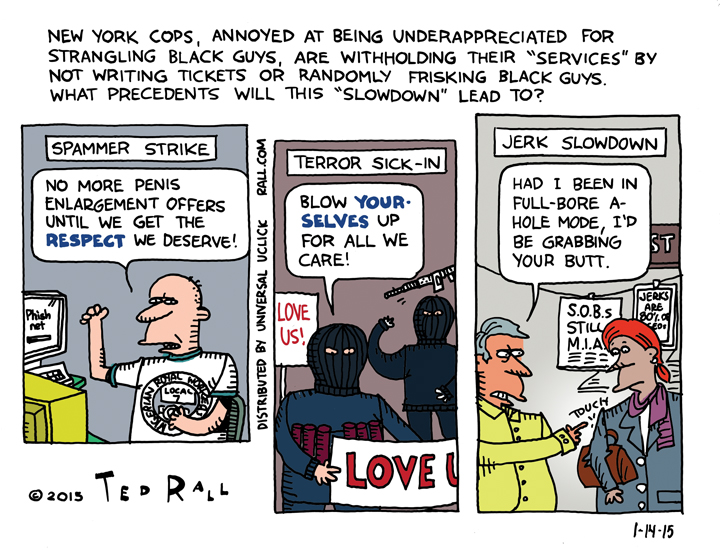The terrorist attacks of September 11, 2001 left a bunch of ridiculous legacies that pretty much everyone with an ounce of sanity agrees we should let go. For example, let’s get rid of the TSA and go back to the old days of airport security. And let’s stop saying that we have to do something before we think about what to do.
9/11 Had Nothing to Do with Afghanistan
Better late than never: most Americans now believe that invading Afghanistan was a mistake. But what good does it do to recognize a screw-up unless you learn from it?
Failure to understand what went wrong, and why, sets you up for doing the same thing later. That’s what happened after Vietnam; rather than face up to the truth that we went there to prop up a corrupt puppet regime and exploit natural gas, we wallowed in ridiculous “Rambo” mythology about politicians stabbing our valiant warriors in the back by not allowing them to win, and libels of vicious hippies who supposedly spat on veterans returning to their hometown airports. (Never happened.)
It’s tempting to kick the dust of Afghanistan off our metaphorical boots and, as Americans prefer, look forward rather than backward. But an advanced civil society requires an after-action report. That’s what the military and other organizations do after an engagement in an intelligent effort to repeat what worked and avoid what didn’t.
Unless we conduct a sober reassessment of Afghanistan, ideally in the form of a congressional investigation, there is nothing to indicate that we wouldn’t start a similarly stupid war again in the future. That’s because the invasion and occupation of Afghanistan was based on a big lie — and that lie is still circulating as widely as it was when the first bombs started raining down on Kabul in October 2001. If we want to avoid another $2 trillion war that claims thousands of American lives, we have to drive a stake through that BS narrative.
Big Lie: Afghanistan and the war against it was revenge for 9/11.
American voters like wars that are framed as righteous retribution against unprovoked acts of naked aggression, like the Spanish-American War (“remember the Maine!”) and World War II in the Pacific (“remember Pearl Harbor!”). Never mind that we invaded Cuba over an accidental explosion that Spain almost certainly had nothing to do with and that a U.S.-led oil embargo drove Japan to the desperate act of bombing Hawaii. A war that seems to come out of thin air, like the Bush Administration’s 2003 invasion of Iraq, on the other hand, prompts big protests and widespread opposition.
So it’s easy to see why the White House and its press allies marketed the Afghan war as revenge against Al Qaeda. We were attacked. It was unprovoked (not really, but that’s what Americans thought). We had to strike back.
Al Qaeda was based in Pakistan. 9/11 was planned in Pakistan. Osama bin Laden, the man held most responsible, lived in Pakistan. Much of the money came from Saudi Arabia, by far the largest international funding source of radical Islamic fundamentalism. The hijackers were Saudi and Egyptian. Not a single hijacker was Afghan. The hijackers had attended training camps in Afghanistan for jihad generally, not 9/11 specifically. If we were interested in getting even for 9/11, we would have attacked Pakistan or Saudi Arabia instead.
This information is well-known and widely available. Yet President Joe Biden, who deserves accolades for sticking to his guns and pulling out U.S. troops, chose September 11, 2021 as the final deadline for the withdrawal and the official end date of the war. “Setting the 9/11 date…underscores the reason that American troops were in Afghanistan to begin with — to prevent extremist groups from establishing a foothold in the country again that could be used to launch attacks against the U.S.,” the Associated Press reported on April 14th.
“Again”?!
There it is, 20 years later, the big lie again. 9/11 wasn’t planned by terrorists from a “foothold” established in Afghanistan. It was planned by terrorists from a foothold established in Pakistan, specifically in the city of Karachi, precisely at the home of Khalid Sheikh Mohammed.
In total opposition to the facts, Biden keeps repeating the big lie. “As I said in April, the United States did what we went to do in Afghanistan: to get the terrorists who attacked us on 9/11 and to deliver justice to Osama Bin Laden, and to degrade the terrorist threat to keep Afghanistan from becoming a base from which attacks could be continued against the United States. We achieved those objectives. That’s why we went.”
Afghanistan never was a “base” of attacks against the United States; said attacks couldn’t possibly “continue” because there never were any originating from Afghanistan. Bin Laden, of course, was assassinated in Pakistan. Which is an entirely different country from Afghanistan. And no, we didn’t follow any trail from Afghanistan to Pakistan.
Biden piles on the lies. People remember symbolism.
Choosing the 20th anniversary of the 9/11 attacks as the official withdrawal date was the White House’s way to reinforce the long-standing national slander against Afghanistan, while leaving our frenemies Pakistan and Saudi Arabia off the hook.
We have got to stop talking about 9/11 and Afghanistan in the same breath.
The lie that links Afghanistan to 9/11 is so powerful that even people on the progressive left bought into it. Only one member of Congress, Barbara Lee of California, had the courage and brains to vote against the Afghanistan war. The antiwar left cobbled together a few pathetic protest demonstrations during the September-October 2001 run-up to the U.S. invasion, but their number and turnout was a tiny fraction of those who marched against the Iraq War. Even now that it’s clear that both wars were equally unjustified and based on lies, liberals get much more agitated over Iraq than Afghanistan.
As usual, the media is the guiltiest cog in the machine of militarism. “Americans like me ignored—or scorned—protesters who warned of an endless quagmire in Afghanistan. Next time, we should listen to the critics,” Conor Friedersdorf kindly acknowledged in The Atlantic in 2019. Perhaps that will happen somewhere somehow. But not in The Atlantic. Like every other corporate media outlet, the magazine refuses to hire me or any other writer or artist who criticized the Afghanistan war when everyone else was all in.
(Ted Rall (Twitter: @tedrall), the political cartoonist, columnist and graphic novelist, is the author of a new graphic novel about a journalist gone bad, “The Stringer.” Now available to order. You can support Ted’s hard-hitting political cartoons and columns and see his work first by sponsoring his work on Patreon.)
When You Find out You’ve Been Doing Terrorism Wrong
It was astonishing to watch hapless Capitol Police not only be easily overwhelmed by a mostly unarmed rabble as they invaded the Capitol building, but some police so clearly ideologically aligned with the protesters who wanted to reverse the election in favor of Trump that they moved gates aside to let them pass and took selfies with them.
If the Roles Were Reversed, and ISIS Had Assassinated President Trump
After US special forces assassinated the head of the Islamic State, the reaction among American political officials, especially the president, and also journalists, was shocking. No one questioned illegality of the killing despite executive order 12,333, which specifically prohibits political assassinations by employees of the United States government. Journalist stupidly and openly asked the question of whether the group would now come to an end as a result. Overall, the reaction was shockingly callous and lawless.
Don’t Worry, the Government Will only Use Their New Anti-Mass Shooting to Suppress Us
Right wing politicians are using the latest mass shootings in Dayton and El Paso as an excuse to say that they need the same sweeping rights to invade privacy that they currently use to combat foreign terrorists against potential American domestic terrorist threats. It’s not hard to see how these tools would quickly be used to crack down on any form of dissent.
If Other Nations Mourned Like the U.S.
What if other countries mourned their national tragedies the way we do? The United States reads off the names of the dead during annual commemoration ceremonies and builds walls with names. Other countries have far bigger death counts, often due to us, but the scale of the carnage makes it impossible for them to wallow in such niceties.
SYNDICATED COLUMN: NYC Attack: Another Reason to Protect Bicycle & Pedestrian Paths
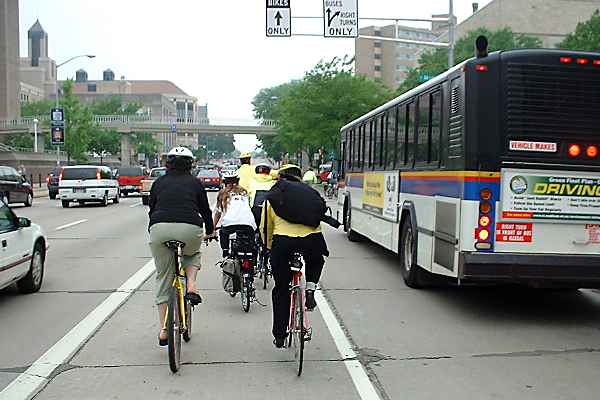
This week’s ISIS-inspired truck attack in lower Manhattan by Uzbek immigrant Sayfullo Saipov has prompted discussions on a number of fronts. There is blowback, the foreign-policy-chickens-come-home-to-roost indicated by an increasing number of radical Islamists emerging from the former Soviet republic of Uzbekistan, a Central Asian nation whose brutal dictatorship is financed and armed by our U.S. taxdollars.
There is the ongoing verbal diarrhea of our mentally diseased president, whose tweets that Saipov deserves the “DEATH PENALTY” (caps his) were overshadowed by his even more outlandish suggestion that the suspect be reclassified as an “enemy combatant” (a Bush-era phrase undefined by American law) and sent to the U.S. torture-concentration camp at Guantánamo. Always the opportunist, Trump also said the “diversity visa” program ought to be abolished because Saipov came to the U.S. under what is more commonly known as the visa lottery.
Seems to me that the biggest issue raised by the New York attack is the one we’re not talking about: the need to protect bicyclists from cars and trucks on public roadways.
Saipov drove his rented Home Depot truck down the West Side Highway onto what becomes West Street, the six-lane road that follows the Hudson River in Manhattan. At Houston Street, just south of Greenwich Village, he made a quick right and a quick left onto the joint pedestrian-bike path that runs alongside the highway. There he mowed down cyclists and pedestrians, killing eight people.
Those eight people aren’t dead solely due to Saipov. They were also killed by the City of New York and its lousy urban planning.
Though in recent years there has been considerable progress in terms of setting aside asphalt for bike paths, walkways and urban parklets in New York and many American other cities, city officials seem largely oblivious to the risks of placing soft human bodies in close proximity to speeding cars, SUVs and trucks.
New York, where I live, is one of numerous cities to report success with bike-rental programs. Ours is called Citibike; you rent a bike from a kiosk and return it to a docking station near your destination. In between you make your way down and across city streets, where cars and trucks rule.
I almost understand the city’s reluctance to dedicate a bike lane to, or to dedicate entire streets to, along smaller crosstown thoroughfares. They’re too narrow; you’d have to eliminate a lot of street parking, which would create more congestion. But the way New York has handled bike lanes along big boulevards is nothing short of inexplicable.
Nothing separates the bike lane from motor vehicle traffic but a line of white paint or, in some cases, short plastic sticks. Forget terrorism — hype aside, terrorism kills so few people that the only rational way for individuals to respond to it is to ignore it and live your life. It’s the ordinary accidents that worry me: two cars collide, one or both lose control and enter the bike path. It happens all the time in New York and elsewhere.
The West Street path where Saipov murdered his victims benefits from a short jersey barrier along the automobile section. But it’s easily accessible to even a large truck driven by a person of ill will, as we saw a few days ago — not to mention the random drunk who thinks it’s a service road. And it contains yet another ridiculous design flaw: putting pedestrians and bicyclists in the same space. Cyclists weave between walkers, terrifying them. Walkers are oblivious to cyclists, creating more accidents. Each deserve safe, discrete spaces to enjoy the outdoors.
What’s maddening about this is that this is the kind of tragedy that is predictable and easy to avoid with minimal expense. Bike paths running adjacent to traffic should be separated by solid concrete or metal barriers between intersections. At intersections, a series of metal bars wide enough to allow bikes to pass through but too narrow for cars, and solid enough to stop one traveling fast, should be installed.
The same precautions should be taken along densely-populated urban streets in order to protect pedestrians. In May 2017 a man high on PCP drove on a sidewalk in Times Square, killing a woman and leaving more than dozen others injured. But it would have been worse had his vehicle not been blocked by a bollard. Sturdy metal barriers should be installed along busy streets to protect pedestrians from out-of-control cars; at intersections they should go with those poles I mentioned above.
You can’t protect everyone. You can’t anticipate every nefarious plot. But disasters that are predictable, easy to avoid or mitigate, and relatively inexpensive are a no-brainer.
(Ted Rall (Twitter: @tedrall) is author of “Trump: A Graphic Biography,” an examination of the life of the Republican presidential nominee in comics form. You can support Ted’s hard-hitting political cartoons and columns and see his work first by sponsoring his work on Patreon.)
Americans Against Extremism
Breathess stories about Muslims fighting extremism by promoting moderation in their home countries have become so commonplace, and so cheesy, that they’re a cliché. It’s especially bad since they look like sellouts merely by being praised by Americans! What if Americans went on Arab television channels for analogous, equal ridiculous, self-promotional opportunities?
Al Qaeda claims credit for Charlie Hebdo attacks
Al Qaeda claims credit for Charlie Hebdo attacks
All in with Chris Hayes
MSNBC TV
January 14, 2015

